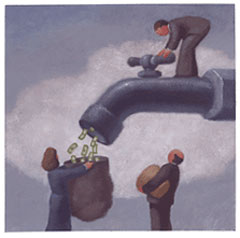Procurement managers, both individually and as part of the procurement function within companies, are used to be measured on how much "savings" their efforts achieved.
But what do savings really mean? How are they measured? And is that measure the best procurement managers can hope for?
Supply Chain Digest Says... |
 |
| Nearly half of finance leaders claimed that 20% or less of procurement savings show on the bottom line.. |
 |
What do you say? |
| Click here to send us your comments |
 |
| Click here to see reader feedback |
|
|
These questions have been tacked by many procurement experts over the years. One of the latest: thoughts from Malcolm Harrison, CEO of CIPS, basically the UKs' version of the US Institute for Supply Management.
Harrison recently offered his thoughts on CIPS SupplyManagement.com web site.
Harrison notes that for many years there has been talk of procurement becoming more strategic, tackling supply chain risk management, driving supplier innovation, supporting M&A and other pursuits that are seen as being more strategic than the basic process of negotiating and buying.
"These activities can be directly linked back to making savings, or rather to delivering commercial benefits – they are not mutually exclusive," Harrison say. "The trick is to make that link more overt."
But Harrison said the new strategic focus can cause procurement managers to sight of the number 1 priority.
He cited the example of Fabio Francalancia, group procurement director at Sky, who said "If you are in an interview with me and you say, 'I don't want to do savings', then the interview is over."
So, Harrison says, "It almost feels like we need a major rebrand on [procurement] savings."
How, he asks, can a company accurately measure savings when it has never bought a given commodity or item before or when the market price, and the price it paid, has increased?
He also notes that operational savings that result from supplier innovation or process improvements, or the social value achieved from procurement-led sustainability initiatives, all bring real commercial benefits and are usually are supportive of business objectives - they just may not always deliver clear "cash releasing" savings.
(See More Below)
|
CATEGORY SPONSOR: SOFTEON |
|
|
| |
|
|
And then there is this question: what if beating a supplier down on price results in that supplier giving a competitor a market-changing innovation first? The savings achieved from price negotiations will likely be dwarfed by the lost opportunity for commercial benefits from the innovation.
 Harrison says a man named Tomas Veit, head of procurement at beer maker Asahi, has an interesting of encouraging supplier innovation. That approach involves creating a dedicated budget for procurement managers to spend time with suppliers at their factories, plants and farms to look for innovative opportunities. Harrison says a man named Tomas Veit, head of procurement at beer maker Asahi, has an interesting of encouraging supplier innovation. That approach involves creating a dedicated budget for procurement managers to spend time with suppliers at their factories, plants and farms to look for innovative opportunities.
Viet cites the example of Asahi's relationship with water and hygiene services provider Ecolab. "In the past traditional way, we would sit with them and push them on price," he said. "It's not like that anymore. We talk about how we can lower water or energy consumption, and they are bringing solutions. It's a new level of partnership."
If you can clearly demonstrate that the process improvements or supplier innovations released cash, you're in great shape. However, Harrison cites a survey by management consultants Protiviti that nearly half of finance leaders claimed that 20% or less of procurement savings show on the bottom line. A smaller 31% of procurement leaders shared this view.
What's more, a third (35%) of procurement leaders rate their sourcing process in delivering value and cost savings as "very effective". Only 20% of finance leaders agreed.
Clearly, finance and procurement don't see eye to eye on this critical subject.
Protiviti said it had been motivated to carry out the study due to perceived shortcomings in the way procurement tracks and communicates savings, how they collaborate with finance departments and how they work with the wider business.
The obvious question: Are finance and procurement always measuring the same thing?
"We must differentiate between cash-releasing savings and other commercial benefits," Harrison concludes. "Both are important, but are not necessarily the same. It is always about adding value; there should always be commercial benefits and often these are cash-releasing savings. Our business functions may be more interested in commercial value, while our finance colleagues will always want to ratify the financials."
Either way, he adds, all roads ultimately lead to what are commonly described as savings. We need an agreed definition for savings, so that we all measuring the same thing or things.
Do you agree with Harrison's thoughts on procurement savings? Let us know your thoughts at the Feedback section below.
Your Comments/Feedback
|